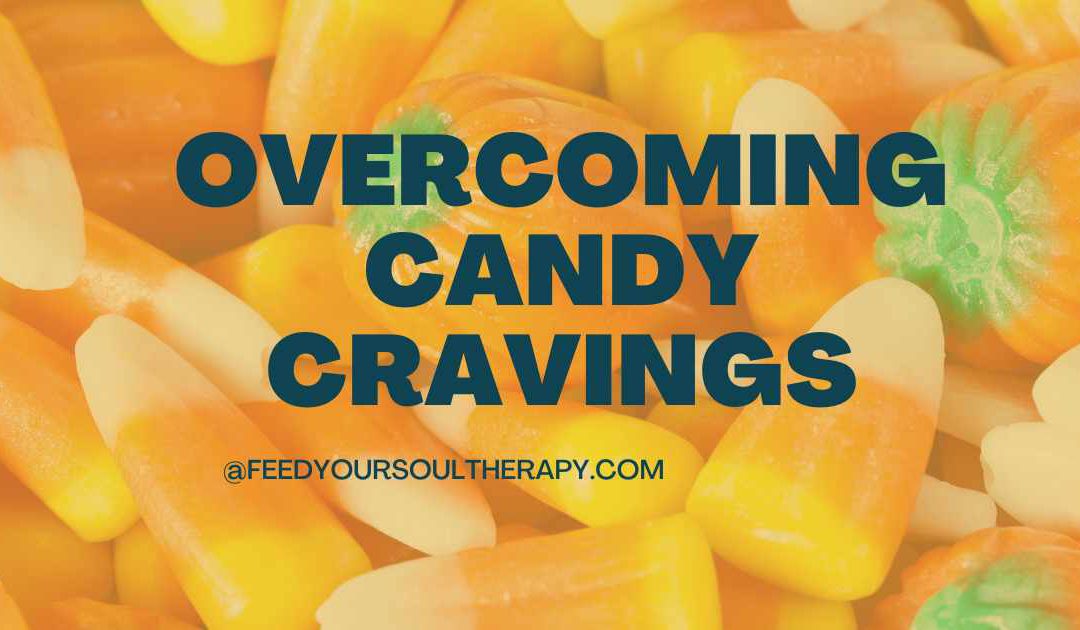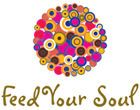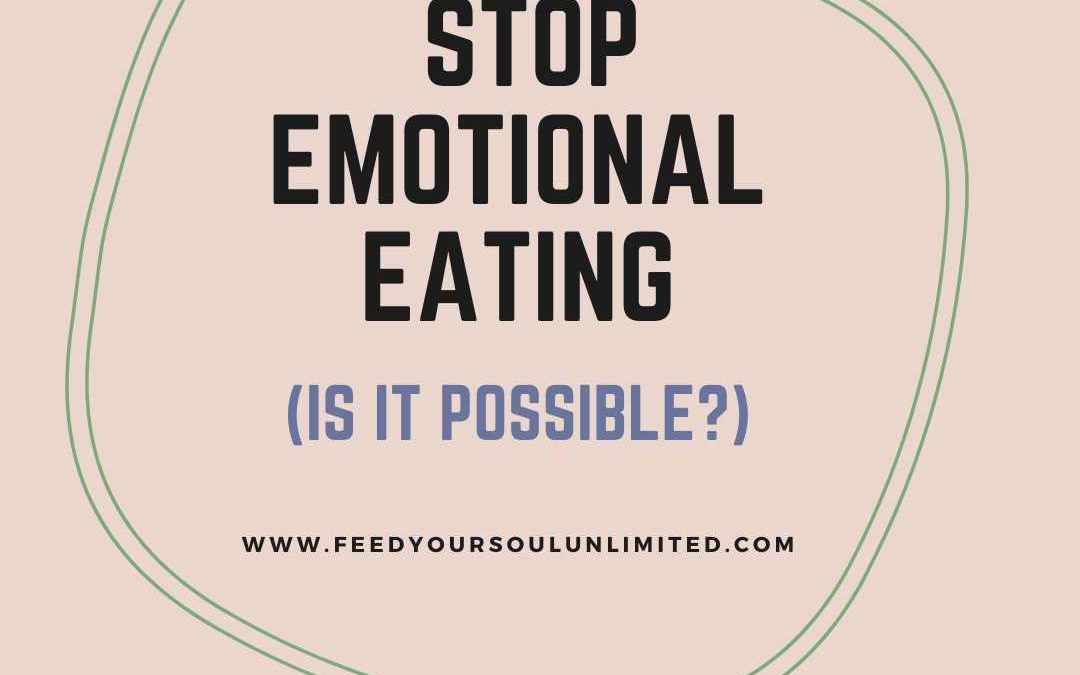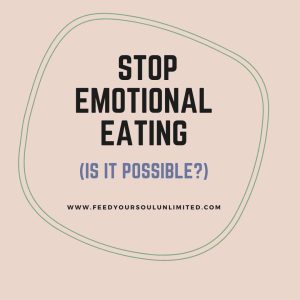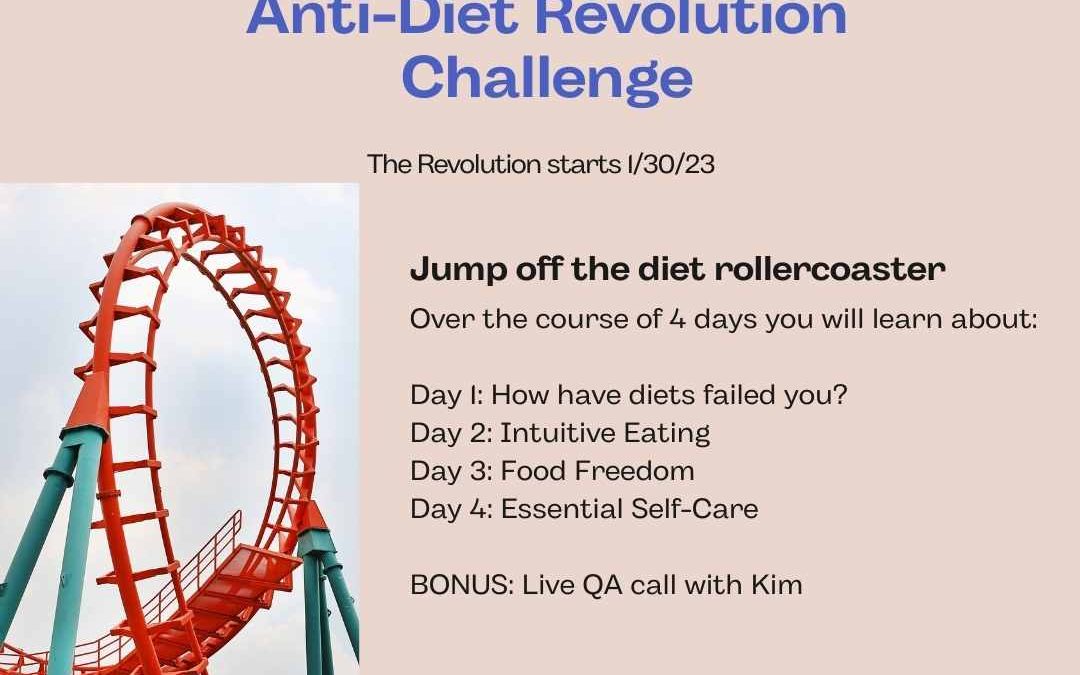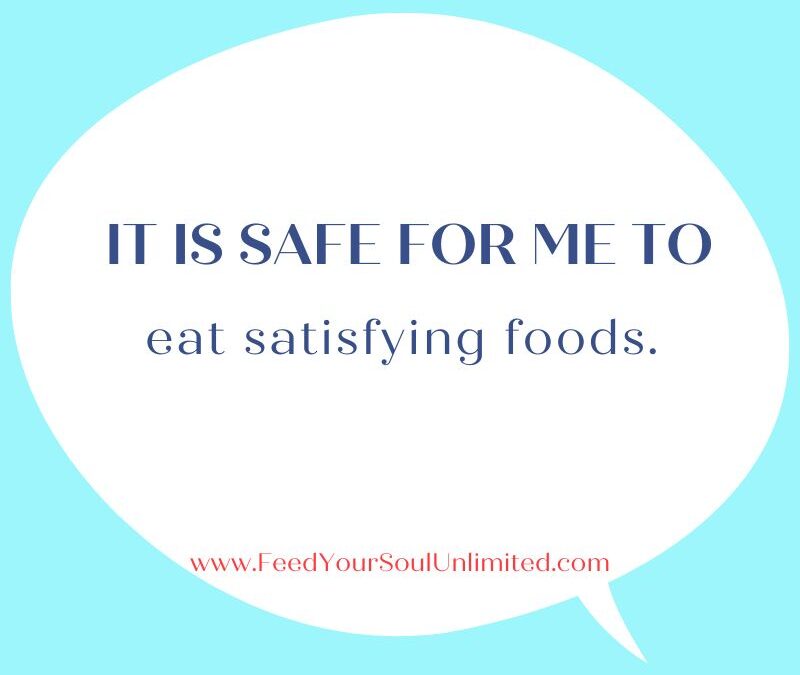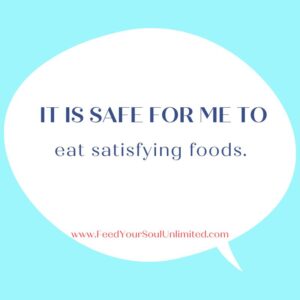
by KimMcLaughlin | Oct 31, 2024 | Binge eating, Holidays




Halloween used to be a tricky time for me, because of all the candy. I was always afraid I would overeat, gain weight and hate myself for it.
The aisles of colorful candy were hard for me to ignore, and my strategies for “managing” my candy intake became more elaborate each year.
If you’ve ever struggled with balancing holiday treats and Halloween candy, my story might sound familiar.
I transformed my mindset around candy—and you can too.
For years, I cycled through various strategies to avoid Halloween candy temptations:
- I bought candy and tried not to eat it!!!
The tactic of not buying candy never worked as planned! I’d buy a stash and vow to leave it alone until Halloween. Inevitably, I’d sneak a piece here and there until I had to replenish it. I would constantly think about the candy and feel compelled to eat it.
- I tried not buying candy at all.
My next strategy was to avoid buying it altogether. This strategy worked, because it was not in my house. I felt uncomfortable because I was avoiding dealing with candy. I wanted to feel comfortable with candy around AND not eat it all.
- Avoiding Trick-or-Treaters was one of my interesting plans.
For years I would go to the gym on Halloween night to avoid being home when trick-or-treaters came by. If I got home while they were still out, I would hide in my bedroom and keep all the lights off. I feared Halloween for all of the wrong reasons.
- Escaping to a Friend’s House
Some years. I would go to my friend’s house for the night to skip the candy stress. I thought if I just avoided the candy, I would be ok.
My husband LOVES to give out Halloween Candy.
I realized while I was dating my husband that he loves giving out Halloween candy to neighborhood kids.
Since he gave out candy and it was in the house, I realized I needed to come up with a different plan.
Next, when my daughter arrived, I knew it was time for a real change.
I found Intuitive Eating is the key component to heal my relationship with Halloween Candy.
Intuitive Eating showed me that food doesn’t have to be the enemy. I didn’t have to “manage” or “control” candy or any other foods. This idea was incredibly freeing, though it took some time to fully embrace.
Key Lessons in My Food Freedom Journey
There some components to help you understand how to use Intuitive Eating.
First, candy isn’t the enemy.
Realizing that there are no “bad” foods—even candy—was huge for me. Halloween candy wasn’t going to harm me, and I didn’t need to label it as something forbidden. When I take candy off of the “bad” list, it does not have power over me.
Second, fear and candy don’t have to go together.
Candy used to scare me because I feared losing control, gaining weight, or somehow “failing” my health goals. By letting go of these fears, I allowed myself to see candy as just candy. If I feel the fear, I focus on dealing with the fear NOT the candy.
Third, allowing myself to enjoy Halloween Candy.
Since I give myself permission to eat candy whenever I felt like it, removed its power over me. It was no longer a “special” or “forbidden” treat. It was just a choice, like any other. I have allowed myself to have candy throughout the year and it is not something special to be binged on at Halloween.
How you can begin your Own Journey Toward Candy Freedom???
If you’re working to make peace with candy (or any food), try these steps:
1. Challenge your thoughts about Halloween candy.
You can reflect on why candy feels scary.
- Are you worried about weight gain?
- Concerned about feeling out of control?
- Do you fear “unhealthy” eating?
I like to notice the emotions and thoughts that come up and journal about them. Through the journalling process, I can determine what the feels really mean to me. Once I can see/feel the feelings and determine what I need, then candy is not all powerful.
2. Explore your beliefs around candy
- What messages have you received about candy?
- Do you associate it with guilt?
- Question where these ideas came from and whether they still serve you.
As you explore your beliefs about candy you can see if they are true or not.
If you were approaching candy with kindness rather than fear, what would that look like? Remember, self-restriction doesn’t work in the long term. True balance means allowing yourself to have candy without guilt.
When you choose to eat candy, do it mindfully.
- Savor the taste of the candy.
- Enjoy the experience of the Halloween candy.
- Do you like the taste?
- Is there a point where it does not taste good anymore?
You might find that, over time, candy becomes far less of a big deal.
Now, I happily give out candy to our neighborhood kids. When my daughter returns with her Halloween haul, I can share a piece without the slightest worry.
Candy is just another food, and Halloween is just one day.
If you’re tired of feeling out of control around candy, know that there’s hope. You, too, can find food freedom. By rethinking your relationship with candy, you can make Halloween (and every day) a little sweeter. 🎃🍬
Kim McLaughlin, MA is a Psychotherapist, Speaker, Author, and Coach who specializes in working with people who suffer from binge eating and emotional eating. She is a Certified Intuitive Eating Counselor. She is the author of the best-selling book Feed Your Soul Nourish Your Life! A Six Step System to Peace with Food and the Amazon #1 Best Selling book Discovery Your Inspiration.
You can find Kim on her podcast Feed Your Soul with Kim and you can find it on all podcast platforms.
Wondering if you are an emotional eater? Sign up for the free Am I an Emotional Eater Quiz.

by KimMcLaughlin | Apr 11, 2023 | Emotional Eating





What do you need most to stop emotional eating?
I get asked this a lot.
Do you know that you unknowingly sabotage yourself with food? You engage in behaviors that lead you to overeat!
Emotional eating can be challenging to stop, but there are several things you can do to lessen it.
The first step is to become aware of your emotional triggers for eating. Ask yourself if you’re eating because you’re hungry or if you’re using food to cope with emotions such as loneliness, stress, boredom, anxiety, or sadness.
The second step is to learn AND use healthier coping mechanisms. Identify strategic ways to deal with emotions, such as exercise, meditation, reading, or talking to a friend or therapist.
The third step is to practice mindful eating by paying attention to the taste, texture, and smell of food, and eating slowly and without distractions. Eating mindfully helps you be connected to your body and all the physical triggers to eat.
You can unknowingly sabotage yourself with food, by not recognizing and stopping the root of the problem:
- Eating to deal with emotions can lead to dissatisfaction with your body and yourself. When you eat emotionally, you are not dealing with the emotional problem, you are making the problem worse.
- Restrictive dieting and depriving yourself of certain foods can lead to intense cravings and binge eating. Limiting ourselves makes the rebel side come out and what to eat what it wants.
- Skipping meals and limiting food can lead to overeating later in the day, especially if you’re hungry and tired.
- Judging yourself and your behavior creates a negative mindset. This negative mindset starts a cascade of negative reactions that include overeating.
What can you do to create more food freedom?
First, practice Intuitive Eating. Learn to listen to your body’s hunger and fullness cues. Give yourself permission to eat all types of foods starting when you are hungry and ending when you are satiated or full.
Second, surround yourself with people who support your goals and create a positive and supportive environment at home and work. Hang out with people who are listening to their bodies and do not engage in diet talk.
Third, practice Self-Care. Take care of your physical, emotional, and mental health by getting enough sleep, eating good food, managing stress, and engaging in activities that bring you joy.
Fourth, seek help if you are struggling. Join a program where the focus is on Intuitive eating. If you’re struggling with emotional eating, consider seeking help from a therapist or registered dietitian who specializes in this area.
Want to get out of the cycle of yo-yo dieting and end emotional eating? We are having a live round of our signature program Emotional Eating Solutions. Check us out to save your spot. https://feedyoursoulunlimited.com/emotional-eating-solutions-self-study/
Kim McLaughlin, MA is a Psychotherapist, Speaker, Author, and Coach who specializes in working with people who suffer from binge eating and emotional eating. She is a Certified Intuitive Eating Counselor. She is the author of the best-selling book Feed Your Soul Nourish Your Life! A Six Step System to Peace with Food and the Amazon #1 Best Selling book Discovery Your Inspiration.
You can find Kim on her podcast Feed Your Soul with Kim and you can find it on all podcast platforms.
Wondering if you are an emotional eater? Sign up for the free Am I an Emotional Eater Quiz.

by KimMcLaughlin | Jan 26, 2023 | Lifestyle





Having an Anti-Diet Revolution is a pretty bold statement and desire. I have been on a mission to help people make peace with food and their bodies for years. I use intuitive eating as the framework to guide my clients to success.
There is this societal norm that we are supposed to want to be “healthy” and thin and the only way to get there is to go on a diet. We have agreed that the only way to get to thinness and “health” is through dieting.
Why have we all bought into the idea that “health” and thinness is our goal? We have been sold to by the LARGE corporations that make a lot of money (hello 60+Billion-dollar industry) off us failing.
I have many examples of going on the same diet over and over expecting a different result. I look back and wonder why in the world I did that. I am not stupid. I now see that I bought into the idea of what my body should look like, and I needed eat differently to make it right.
I bought into the idea that something was wrong with me, because of my size. The problem is the way I tried to fix my weight was by dieting.
Dieting does not accomplish what they say it will. It does not equal health.
There is an inherent harm in dieting, because it is focused on the external: what you eat and how much you weigh. Diets do not address why you overeat, why you binge, why you are obsess with food and can’t stop eating. Dieting leads to deprivation which leads you back to binging and the cycle starts up again.
If dieting is not the answer to overeating, what is?
Intuitive Eating is the way to move out of dieting and into a place of peace with food.
Imaging being able to notice when you are hungry and make decisions about what you shall eat easily. Your decision is not based on some system where you must track how much you eat. Eating the food and enjoying it. Noticing when you are satisfied and stop eating. Feeling energized with the food you eat. Getting a rhythm with food where you have a sense of what foods you like, what you do not like. Feeling empowered to eat what you want and not overanalyze it. Being able to determine what are your right foods that fit well with your body. There is no obsession with food. You can enjoy what you eat and if you eat beyond fullness you are able to course correct.
What does it take to be an intuitive eater?
- Notice when you are hungry.
- Notice what are the foods that satisfy you and give you the energy you need.
- Eat when you are hungry and before you are overly hungry.
- Stop when you are satisfied or gently full.
- Allow yourself to eat the foods you really want.
- Notice feelings that are causing you concern and take care of them.
- Engage in self-care and self-love.
- Notice thoughts that are negative and have ways to deal with them.
- Have a mindfulness practice that is soothing.
- Engage in movement that is right for you.
It takes time and energy to embrace intuitive eating and it will be the best thing you can do for yourself.
To move towards Intuitive eating, we are going to have the Anti-Diet Revolution. What is the Anti-Diet Revolution? We look at diet, diet culture and how YOU have been led astray.
We cannot end at ending dieting. What will you do instead?
- Have a way to measure hunger and fullness. This is a simple and profound practice that takes guess work out of eating.
- Determine what leads you to overeat.
- Have action plan for your self-care that REALLY work.
- Be in a place where others understand what you are experiencing, and you feel in community.
Join us for the Anti-Diet Revolution starting soon. Sign up now to get access to this free series to help you move out of dieting and into a plan of action that works.
Kim McLaughlin, MA is a Psychotherapist, Speaker, Author, and Coach who specializes in working with people who suffer from binge eating and emotional eating. She is a Certified Intuitive Eating Counselor. She is the author of the best-selling book Feed Your Soul Nourish Your Life! A Six Step System to Peace with Food and the Amazon #1 Best Selling book Discovery Your Inspiration.
You can find Kim on her podcast Feed Your Soul with Kim and you can find it on all podcast platforms.
Wondering if you are an emotional eater? Sign up for the free Am I an Emotional Eater Quiz.

by KimMcLaughlin | Aug 2, 2022 | Emotional Eating, Emotions




Do you have Food Satisfaction after you eat?
Whether you are satisfied or not is very personal and individual: each person is different and has different requirements.
We have often learned to deny our satisfaction, especially when we have been following the diet culture.
In order to look at satisfaction better, let’s examine the definition of satisfaction:
- “Fulfillment of one’s wishes, expectations, or needs, or the pleasure derived from this.”
Can you imagine looking at food as a fulfillment of your wishes, expectations or needs?
Could you see yourself being ok with getting pleasure from food? Often the answer to these questions is NO. Why? We are not allowing ourselves to get pleasure from food.
Intuitive eating asks us to look at the ‘satisfaction factor.” Meaning we chose food because it is satisfying to us!
How radical is that?
Have you ever considered how to be more satisfied with food?
Increasing food satisfaction is a multipronged approach.

Consider some of the qualities you can use to determine food satisfaction:
- Texture: Is the food hard, smooth, crunchy?
- Smell: Is the food pleasant smelling?
- Sound: What is the sound when you bite into the food item?
- Temperature: Is the food hot, spicy, cold, frozen, or room temperature?
- Flavor: Is the food yummy, bland, awful, ok?
- Appearance: What does the food look like? Does it look appealing?
- Do you get full with this food?
- What are your surroundings? Appealing, attractive or bland?
We tend to discard the satisfaction factor, because we have been trained that if the food is appealing, yummy, filling: then it must be “bad” food.
Bad food is determined to be:
- High in calories
- Lots of fat.
- Too much salt.
- Full of sugar.
In order for food to be “good” food it is:
- Diet food
- Low calories
- Low in fat
- Fitts into whatever diet you are on.
To increase your food satisfaction further consider the following questions:
- Do you taste your food?
- Are you eating too fast?
- Have you eating when you are too hungry?
- Can you eat past enjoyment?
- Is there food enjoyment?
How can you increase your Food Satisfaction and Intuitive Eating?
First ask yourself, What do I really want to eat?
Next you can ou can look at the food qualities like:
- How will this food sound?
- Does the food look appealing?
- How does this food feel in my mouth?
- Do I want it to be hot or cold?
- What will my body feel when I am done eating this?
- Which emotions might show up after I am done?
Then start eating from gentle hunger. Be sure to enjoy your food
After you eat, reflect on the food/satiety.
- Did the food meet my needs?
- Am I satisfied?
- Did I end up not eating what I really wanted?
Satisfaction with food is one way out of overeating and into intuitive eating.
When you are satisfied with the food you feel better physically, emotionally, and mentally.
Being present with feeling of food satisfaction is a gift you can give yourself.
Take some time today, focus on satisfaction with your food. See how it helps you get in touch with your body, so then you are not overeating.
 Kim McLaughlin, MA is a Psychotherapist, Speaker, Author, and Coach who specializes in working with people who suffer from binge eating and emotional eating. She provides therapy to high achieving women in California.
Kim McLaughlin, MA is a Psychotherapist, Speaker, Author, and Coach who specializes in working with people who suffer from binge eating and emotional eating. She provides therapy to high achieving women in California.
Kim is a Certified Intuitive Eating Counselor.
She is the author of the best-selling book Feed Your Soul Nourish Your Life! A Six Step System to Peace with Food and the Amazon #1 Best Selling book Discovery Your Inspiration.
You can find Kim on her podcast Feed Your Soul with Kim and you can find it on all podcast platforms.
Wondering if you are an emotional eater? Sign up for the free Am I an Emotional Eater Quiz.

by KimMcLaughlin | Jul 12, 2022 | Emotional Eating, Holidays, Lifestyle, Self-Love




When my daughter was in preschool, she came home with a paper listing 100 items for a “Summer Bucket List.” The paper proclaimed it had 100 fun things to do before summer kicks the bucket.
This list had many items on it that were associated with summer:
- Swim until dark.
- Walk on the beach.
- Have breakfast for dinner.
I had heard of a bucket list as being kind of morbid related to what you want to do before you die. It had never occurred to me that it could be expanded to a list you want to do over the summer.
I looked at that list for a while and decide to make my own Summer Bucket List for me and my family. Now each summer we discuss what activities we want to do. I have learned that the only way to get these kinds of activities on the calendar is to write them down AND put them in the calendar. What is not on the calendar does not seem to get done.
I like the idea and opportunity this gives us to be creative and ask for what we want over the summer. This list is fluid and can expand or contract as needed.
This Summer Bucket List is so fun and gets me and my family really thinking about what we each want over the summer.
I love the Summer Bucket List, because it does not require you to spend any money, unless you want to.

What do you REALLY want to do this summer?
Each summer I ask clients what they have planned for the summer. Often, they say they do not have much planned. Planning to do something fun IS self-care. The summer is the best time to focus on you and what you want.
I find it is a time of connection with my family, too, to hear what they want to do over the summer. Sometimes the plans are as a family and sometimes the plans are alone or with others.
This summer is a great opportunity to put yourself first and make that list. Have you thought about what fun activities you can do over this summer?
This summer put yourself first on the list.
Here are some strategies to start your Summer Bucket List. I suggest you spend 15-30 minutes contemplating the below questions.
- What do you like to do AND have not done in a while?
- What did you like to do as a child during the summer?
- What have never done, but really want to do.
- What have you been afraid to do but really want to do?
- What would give you pleasure?
- Use the Summer Bucket List to keep track of what you plan to do.
- First write down what you plan to do over the summer.
- Set up dates in your calendar to do them.
- Cross them off when you accomplished them.
- Remember to keep extra spaces on your list to add through the summer.
Enjoying the summer season is just good for you.
Join me this summer and create your Summer Bucket List (download here). Join me in the Feed Your Soul Community Facebook Group where we will support each other to make AND use our Summer Bucket List. Being in community can be the best way to get inspiration and accountability to get your self-care moving forward.
Kim McLaughlin, MA is a Counselor, Speaker, Podcaster, and Inspirational Coach who specializes in working with people who suffer from binge eating and emotional eating. She is a Certified Intuitive Eating Counselor. She is the author of the book Feed Your Soul Nourish Your Life! A Six Step System to Peace with Food and the Amazon #1 Best Selling book Discovery Your Inspiration.
You can find Kim on her podcast Feed Your Soul with Kim and you can find it on all podcast platforms.
Wondering if you are an emotional eater? Sign up for the free Am I an Emotional Eater Quiz.
